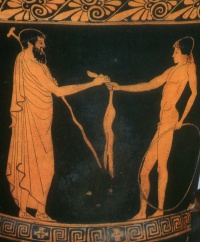Hoop rolling (ancient Greece): Difference between revisions
From BoyWiki
No edit summary |
No edit summary |
||
| Line 1: | Line 1: | ||
[[Image:AEGISTHOS PAINTER -460c Love gift (Kunsthistorisches Museum Wien IV-1102) 852x1030.jpg|thumb|left|200px|'''Love gift'''<br>Man presents a leg of mutton to a youth with a hoop, in an allusion to boylove.<ref>''Antike Welten: Meisterwerke griechischer Malerei as dem Kunsthistorischen Museum Wien'', 1997, pp.110-111</ref> Athenian red-figure vase, ca. 460 BC]] | [[Image:AEGISTHOS PAINTER -460c Love gift (Kunsthistorisches Museum Wien IV-1102) 852x1030.jpg|thumb|left|200px|'''Love gift'''<br>Man presents a leg of mutton to a youth with a hoop, in an allusion to boylove.<ref>''Antike Welten: Meisterwerke griechischer Malerei as dem Kunsthistorischen Museum Wien'', 1997, pp.110-111</ref> Athenian red-figure vase, ca. 460 BC]] | ||
The Greeks referred to the hoop as the ''trochus''. | The Greeks referred to the hoop as the ''trochus''. Hoops, also called ''krikoi,'' were probably made of bronze, iron, or copper, and were driven with a stick called the ''elater''.<ref>Athletics and Games of the Ancient Greeks By Edward M Plummer; p50</ref> | ||
The hoop held symbolic meanings in Greek myth and culture. A bronze hoop was one of the toys of the infant [[Dionysus]],<ref>Forerunners and Rivals of Christianity: Being Studies in Religious History from 330 B.C. to 330 A.D. by Francis Legge; 1915 p. 125</ref> and hoop driving is an attribute of [[Ganymede (mythology)|Ganymede]], often depicted on [[Ancient Greece|Greek]] vase paintings from the 5th century BC. Images of the hoop are sometimes presented in the context of boylove ancient Greece.<ref>The ancient Olympics By Nigel Jonathan Spivey; p48</ref> | |||
The hoop | |||
<ref>http://en.wikipedia.org/wiki/Hoop_rolling</ref> | <ref>http://en.wikipedia.org/wiki/Hoop_rolling</ref> | ||
Revision as of 22:16, 26 September 2013

Man presents a leg of mutton to a youth with a hoop, in an allusion to boylove.[1] Athenian red-figure vase, ca. 460 BC
The Greeks referred to the hoop as the trochus. Hoops, also called krikoi, were probably made of bronze, iron, or copper, and were driven with a stick called the elater.[2]
The hoop held symbolic meanings in Greek myth and culture. A bronze hoop was one of the toys of the infant Dionysus,[3] and hoop driving is an attribute of Ganymede, often depicted on Greek vase paintings from the 5th century BC. Images of the hoop are sometimes presented in the context of boylove ancient Greece.[4]
References
- ↑ Antike Welten: Meisterwerke griechischer Malerei as dem Kunsthistorischen Museum Wien, 1997, pp.110-111
- ↑ Athletics and Games of the Ancient Greeks By Edward M Plummer; p50
- ↑ Forerunners and Rivals of Christianity: Being Studies in Religious History from 330 B.C. to 330 A.D. by Francis Legge; 1915 p. 125
- ↑ The ancient Olympics By Nigel Jonathan Spivey; p48
- ↑ http://en.wikipedia.org/wiki/Hoop_rolling
- ↑ http://en.wikipedia.org/wiki/Athenian_pederasty